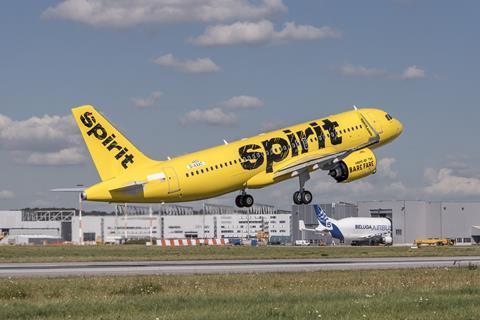Spirit Airlines has reduced its capacity forecast for the first quarter as the scope of its Pratt & Whitney geared turbofan (GTF) engine issues come into focus.
“We did not foresee the number of parked [Airbus A321neo] aircraft in 2024 and beyond due to GTF engine availability, further complicating and delaying our ability to achieve full fleet utilisation,” chief executive Ted Christie said during Spirit’s 8 February earnings call.
For the first quarter, Spirit estimates its capacity will increase about 1.5% year on year, which Matt Klein, Spirit’s chief commercial officer, says is ”about 5.5 percentage points lower than we projected back in October”.

Based on current assumptions about engine removals related to P&W’s recall of hundreds of PW1100Gs, Spirit is expecting full-year 2024 capacity to be flat or up by low single-digits over last year.
”About half of this area is related to the reduction of scheduled flights in off-peak days,” Klein says. “The other half is… having to pull new aircraft for service to position them for engine removals due to the powdered metal disc inspections.”
The South Florida-based ultra-low-cost carrier (ULCC) says that an average of 13 of its Airbus A320-family aircraft were grounded for P&W engine inspections in January.
Spirit is planning for an average of 25 aircraft to be grounded for the full year of 2024, and for an average of 40 jets to be grounded during the fourth quarter.
The carrier operates an all-Airbus fleet of about 205 jets.
”We won’t be able to achieve what we would consider an optimised cost structure until we get past the engine availability issues,” says chief financial officer Scott Haralson.
Spirit is working with P&W “to predictably manage the [engine] removals and finalise a compensation arrangement”, he says. The carrier is seeking compensation but has yet to finalise terms with P&W.
It is unclear to what extent Spirit’s fleet will remain constrained by engine availability issues beyond this year. “Looking into 2025 is tough to estimate,” Haralson says. “There’s a lot of things that we’re doing and Pratt is doing to help manage the number.”
MAJOR LOSSES
Spirit’s troubles extend beyond GTF engines, as its long-sought tie-up with JetBlue Airways was recently struck down by a US district court on antitrust grounds. The carriers are appealing the decision, with a court hearing scheduled for June.
Meanwhile, the ULCC lost $447 million on the full year of 2023, compared with a $554 million loss the previous year.
It reports a fourth-quarter loss of $184 million on $1.3 billion in revenue, compared with a $271 million loss on $1.4 billion of revenue during the prior-year period.
“Shifts in the balance of supply and demand for domestic air travel in leisure markets during last summer and fall had a very profound impact on revenue trends for the second half of 2023,” Christie says.
Spirit is making network changes in response to its “unsatisfactory” results, Christie says, including greater emphasis on flying during peak periods of demand for air travel, and tweaking its geographic market concentrations.
“We’re not prepared to share all of the details of our plan with you today as we await clarity on our appeal,” he says.


























